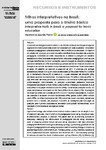Mostrar o rexistro simple do ítem
Roteiros Interpretativos no Brasil Unha proposta para o Ensino Primario
| dc.contributor.author | Pedrini, A.G. | |
| dc.date.accessioned | 2020-05-12T07:41:17Z | |
| dc.date.available | 2020-05-12T07:41:17Z | |
| dc.date.issued | 2018 | |
| dc.identifier.citation | de Gusmão Pedrini, A. (2018). Roteiros Interpretativos no Brasil. AmbientalMENTEsustentable, 25(1), 77-115. https://doi.org/10.17979/ams.2018.25.1.4652 | es_ES |
| dc.identifier.issn | 1887-2417 | |
| dc.identifier.uri | http://hdl.handle.net/2183/25548 | |
| dc.description.abstract | [Resumo] O contido da bioloxía no ensino secundario e da bioloxía de ciencia-contido no segundo segmento do ensino primaria pode ser ensinada en clases extraescolares. Un deles é a charla pedagóxica sobre un percorrido interpretativo. Non se sabe a súa eficacia. Os obxectivos do traballo son: a) propoñer un modelo de análise clasificatoria da eficacia das conferencias pedagóxicas dadas en rutas interpretativas; b) analizar se as conferencias en traballos realizados sobre pistas interpretativas presentaron eficacia pedagóxica a través dunha tipoloxía clasificatoria; c) propoñer pautas para a formulación de conferencias pedagóxicas que se adoptarán nun percorrido interpretativo que poida satisfacer o contido da bioloxía ou a docencia científica, abordando un problema socioambiental. Vinte papeis foron seleccionados ao azar de setembro a decembro de 2017. Proponse unha tipoloxía que evalúa a charla con catro niveles de eficacia: a) Plena Eficacia (EP); b) Efectivo (E); c) parcialmente eficaz (PE) d) ineficaz (I). Case todas as clases maxistrais (90%) abordaron cuestións socioambientais. As conferencias foron PE (40%) e Ineficaces (20%), é dicir, o 60% deles non foron de forma completa ou efectiva e unha minoría de 6 (30%) presentaron problemas críticos-Freirian. As conferencias mostraron marcadamente parámetros biolóxicos [flora (100%) e fauna (85%)] e mal humanística [cultura local (45%) e ocupación histórica do territorio (55%)]. A maioría das conferencias realizáronse en pistas interpretativas nos estados de São Paulo (30%) e en Río de Janeiro (15%). As charlas realizáronse en pistas cunha extensión de 0,35-2,9 km e 3-14 puntos interpretativos. O público das clases expositivas é de estudantes de primaria (45%), grandes públicos (30%) e ensino medio (25%). Os camiños interpretativos son 10% subacuáticos, sendo un deles parcialmente terrestre como o resto. Se propoñen cinco modelos de directrices para a formulación de conferencias para 9 puntos interpretativos, abordando un tema socioambiental, baixo a inspiración critica-freireana da educación ambiental. | es_ES |
| dc.description.abstract | [Abstract] High-school biology and middle-school science subject matters can be taught in outof- classroom activities, one of which is the pedagogical lecture along interpretive trails. Its effectiveness, however, is unknown. This papers aims at: a) proposing a model for analytically classifying the effectiveness of pedagogical lectures along interpretive trails; b) analyzing whether lecture activities along interpretive trails have presented pedagogical effectiveness through a classifying typology; c) presenting guidelines for the design of pedagogical lectures along interpretive trails for teaching biology or science by approaching socioenvironmental issues. For that purpose, we have randomly selected 20 works implemented between September and December 2017. The evaluating typology for lectures included four levels of effectiveness: a) Fully Effective (FE); b) Effective (E); c) Partially Effective (PE); d) Ineffective (I). Results revealed 40% PE and 20% I lectures, which means 60% were not E or FE. Almost all lectures (90%) approached socioenvironmental issues, while only 30% (6) presented critical or Freirean interrogations. Their parameters were strongly biologizing – 100% approached flora and 85%, fauna – and faintly humanistic – 45% encompassed local culture, 55% approached the territory historically. Most lectures took place along interpretive trails in São Paulo (30%) and Rio de Janeiro (15%) states, ranging from 0.35 to 2.9km in length and 3 to 14 interpretive spots. Their audience included primary education students (45%), undistinguished groups (30%) and high school students (25%). Submarine trails made 10% of the sample, one of which was partially terrestrial. We finally provide five guideline models for designing lectures for nine interpretive spots, approaching a socioenvironmental issue from a Freirean critical environmental education inspiration. | es_ES |
| dc.language.iso | por | es_ES |
| dc.publisher | Universidade da Coruña, Servizo de Publicacións | es_ES |
| dc.relation.uri | https://doi.org/10.17979/ams.2018.25.1.4652 | es_ES |
| dc.rights | Atribución-CompartirIgual 4.0 España | es_ES |
| dc.rights.uri | http://creativecommons.org/licenses/by-sa/3.0/es/ | * |
| dc.subject | Trilha interpretativa | es_ES |
| dc.subject | Ensino de biologia | es_ES |
| dc.subject | Ensino de ciências | es_ES |
| dc.subject | Aula extraclasse | es_ES |
| dc.subject | Educação ambiental | es_ES |
| dc.subject | Interpretive trails | es_ES |
| dc.subject | Biology teaching | es_ES |
| dc.subject | Science teaching | es_ES |
| dc.subject | Out-of-classroom lesson | es_ES |
| dc.subject | Environmental education | es_ES |
| dc.title | Roteiros Interpretativos no Brasil Unha proposta para o Ensino Primario | es_ES |
| dc.title.alternative | Interpretive trails in Brazil: a proposal for basic education | es_ES |
| dc.type | info:eu-repo/semantics/article | es_ES |
| dc.rights.access | info:eu-repo/semantics/openAccess | es_ES |
| UDC.journalTitle | AmbientalMente Sustentable: Revista científica galego-lusófona de educación ambiental | es_ES |
| UDC.volume | 25 | es_ES |
| UDC.issue | 1 | es_ES |
| UDC.startPage | 77 | es_ES |
| UDC.endPage | 115 | es_ES |






